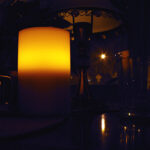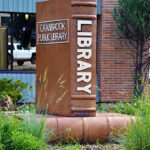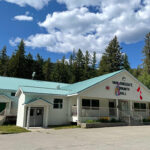Home »

Whitebark Pine plays vital role in forest and bear health
By Shawn Parker
For the past several days there has been people wandering around Kimberley wearing these wooden name tags. They were here for a conference on whitebark pine trees. I attended a slide show and speeches on Friday night. I must admit, I only went because the man in charge of the event is Randy Moody, our landlord and in the past year of living here we’ve come to know the Moodys pretty good. I thought, ‘trees, wow, bring a pillow and a box of granola to use make friends with.’
 But the evening was quite enlightening, regarding the plight of the grizzly bear and the whitebark pine. The problem is white bark pine has fallen victim to pine beetles and an exotic disease called white pine blister rust. White bark pine has been destroying up to 80% in some areas. Another thing I learned, whitebark pine needs a shorter name, so from here on I’ll refer to it as wbp.
But the evening was quite enlightening, regarding the plight of the grizzly bear and the whitebark pine. The problem is white bark pine has fallen victim to pine beetles and an exotic disease called white pine blister rust. White bark pine has been destroying up to 80% in some areas. Another thing I learned, whitebark pine needs a shorter name, so from here on I’ll refer to it as wbp.
Grizzlies and black bears love wbp pine cones. I mean they REALLY LOVE them. They will gorge themselves on the sticky cones. But the cones rarely fall to the ground without assistance. Black bears can climb the trees, so they don’t care. But grizzlies rely on red squirrels to knock the cones down, then store them for the winter. Then the grizzlies sniff out the caches of cones and go to town.
Wpb pine cone seeds are very high in fat. That’s why grizzlies love them so. They eat their fill, then are ready for a six month long nap. The seeds provide the nutrient rich milk the mothers need to feed the cubs.
No wbp= no seeds=no milk=no cubs=no bears.
(That’s environmentally friendly math.)
Although the range of Wpb goes from way down in the southern states to just north of Prince George, the East and Went Kooteney are wbp central. The trees are found primarily on higher elevation. If you’re a hiker, you’ve seen them. You may not know what they look like, but you’ve seen them. The trees are most easily identifiable by their pine needles; they grow in clusters of five needles. Some other trees grow in bunches of two or three, but the wbp has five needles to a cluster.
Here’s where the scientists need your help. The mountains are huge. Researchers can’t go everywhere. They need hikers and other outdoorsy kinda people to let them know where healthy wbp trees are. The trick is, scientists need healthy trees to take seeds from. They’ll grow trees from seeds, then as Michael Murray, from the BC Forestry Service explained, they’ll try to kill the trees. They need to find trees that are immune to pine beetles and blister rust. Once they find trees that are resistant, harvested seeds from these trees will be grown, then those trees will be replanted in the wild. Eventually we will have a healthy forest system again. I’m thinking a GPS could come in pretty useful here.
Healthy white pine bark trees can be reported to Randy Moody at [email protected] or to learn more check out the Whitebark Pine Ecosystem Foundation of Canada’s website at www.whitebarkpine.ca.








